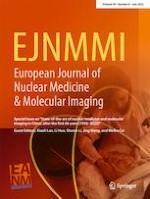21-03-2022 | Original Article
Parametric image generation with the uEXPLORER total-body PET/CT system through deep learning
Published in: European Journal of Nuclear Medicine and Molecular Imaging | Issue 8/2022
Login to get accessAbstract
Purpose
Total-body dynamic positron emission tomography/computed tomography (PET/CT) provides much sensitivity for clinical imaging and research, bringing new opportunities and challenges regarding the generation of total-body parametric images. This study investigated parametric \(K_i\) images directly generated from static PET images without an image-derived input function on a 2-m total-body PET/CT scanner (uEXPLORER) using a deep learning model to significantly reduce the dynamic scanning time and improve patient comfort.
Methods
\(^{18}\)F-Fluorodeoxyglucose (\(^{18}\)F-FDG) 2-m total-body PET/CT image pairs were acquired for 200 patients (scanned once) with two protocols: one parametric PET image (60 min, 0\(\sim\)60 min) and one static PET image (10 min, range of 50\(\sim\)60 min). A deep learning model was implemented to predict parametric \(K_i\) images from the static PET images. Evaluation metrics, including the peak signal-to-noise ratio (PSNR), structural similarity index measure (SSIM), and normalized mean square error (NMSE), were calculated for a 10-fold cross-validation assessment. Moreover, image quality was assessed by two nuclear medicine physicians in terms of clinical readings.
Results
The synthetic parametric PET images were qualitatively and quantitatively consistent with the reference images. In particular, the global mean SSIM between the synthetic and reference parametric \(K_i\) images exceeded 0.9 across all test patients. On the other hand, the overall subjective quality of the synthetic parametric PET images was 4.00 ± 0.45 (the highest possible rating is 5) according to the two expert nuclear medicine physicians.
Conclusion
The findings illustrated the feasibility of the proposed technique and its potential to reduce the required scanning duration for 2-m total-body dynamic PET/CT systems. Moreover, this study explored the potential of direct parametric image generation with uEXPLORER. Deep learning technologies may output high-quality synthetic parametric images, and the validation of clinical applications and the interpretability of network models still need further research in future works.





